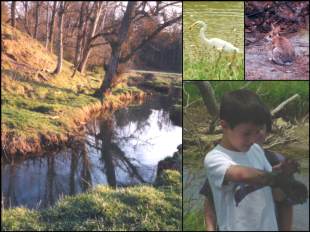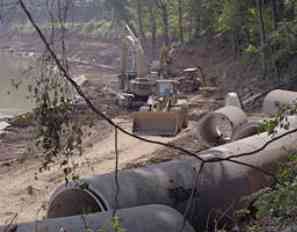About STEP systems
Working together to move forward
Council contact info.
PLEASE ATTEND THE
JUNE 24 PUBLIC MEETING, 4 - 6:30 PM
ISSUES, BACKGROUND, Q&A for JUNE 24 MEETING
|
A Tale of Two Sewers Roanoke Times, June 8, 2003 (guest editorial)
In the year 2003, there was a fine sewer system in the Town of Blacksburg. Sewage bills were low. Overflows were rare. And the Town’s rustic Toms Creek flowed through wildlife habitat for hundreds of species in the Town’s Heritage Park. Nearby in Roanoke, there was also a creek, Tinker Creek, of literary fame, but now polluted from repeated sewage overflows.
Every year, dozens of sewage overflows spilled into the Roanoke River and its tributaries from adjoining sewer lines. And millions of Roanoke taxpayer dollars went down the drain in attempts to fix these problems. Between 1999 and 2003, cost overruns inflated sewage project expenses from $73.5 million to $114.6 million. On May 20, Blacksburg Town Council was presented with a rush plan to make Blacksburg’s sewer system more like Roanoke’s. To fix an impending capacity shortage in the North Main sector of Town, a sewer line through the Toms Creek Basin (TCB) was proposed. It would cross Toms Creek and tributaries 30 times, creating a 12.5-mile, 40-foot swath of destroyed trees. Council was asked to approve either $11.2 million for this sewer line or $5.9 million for North Main Street sewer repairs. Town Staff pressed council to vote on this issue within weeks because newly collected data showed that the North Main Street sewer had reached full capacity flow. Staff did not explain, however, that these full capacity data readings were enormous surges in flow over periods of just a few hours caused by water leaking into sewer lines. These occurred only during recent very heavy rains that broke all-time weather records. During these same few-hour periods of rainfall, millions of gallons of sewage overflowed in Christiansburg, Abington, Wytheville, South Boston, Galax, and Roanoke. Every regional municipality had massive sewage overflows except for Blacksburg. No sewer line in Blacksburg is thus facing imminent failure. A small future problem would not be fixed, but grossly compounded by running a sewer through a creek and floodplains that flood frequently, conditions that aggravate leakage due to seasonal ground stresses on pipe connectors. This discredited engineering practice would yield sewer line overflows, a polluted creek, sewage treatment plan overflows and huge system upgrade costs in future decades, just like in Roanoke. The proposed TCB sewer line would also put an end to Blacksburg’s low sewer bills, with a 52% 3-year sewer rate increase planned to finance the proposed project. With staff proposing only the worst possible alternative to its pet TCB sewer line project, it was left to others to find good options. A council member found a way to run a sewer line along the U.S. 460 bypass to solve North Main’s long-term needs at a cost of $2 to $4 million. Municipal wastewater engineers told citizens of other inexpensive options for the North Main problem, including equalization tanks and non-intrusive measures for inflow reduction. And proven new technology options such as one called “STEP” collection (see www.tcbsewer.org for photos and description) could serve all development through build-out in both North Main and the Toms Creek Basin. STEP was among the wastewater systems recommended by consensus as good options in 2001 by a Town-appointed expert working group after a year-long study. Collectively called distributed sewer, these systems are working reliably, economically, and aesthetically across the nation. One in a dense Denver suburb serves 33,000 residents and mega-shopping malls at a sewage treatment cost of $2.50 per home per month. And a model such system installed in The Village at Toms Creek in Blacksburg has been working successfully for two and a half years. Developers should understand that distributed sewer is sewer. Same service, no restrictions. A system with the size and appearance of a shrub-lined tennis court, absolutely odor free, serves 100 homes. Unless you were a sewer expert, you would never know it was in the community. TCB sewer line advocates are providing inaccurate information about these options. On June 3, for example, council was told of critically important land use figures for distributed sewer systems that were too high by a factor of six. The option of STEP collection for new development was ignored, and a far-fetched plan for putting systems near existing pumping stations was featured instead. Let's not rush, hope, and blunder our way into another sewer fiasco like Roanoke’s in which Toms Creek, Heritage Park and the Toms Creek Basin are seriously degraded and millions after millions of taxpayer dollars go down the drain . If there is a valid case for a TCB sewer line, let it be made to council and residents without a contrived crisis, a rushed time frame, selective presentation of the worst alternatives, and erroneous information about the good ones. Council must take the time to carefully study cost-effective options such as a sewer line along the bypass and STEP collection.Town council has followed an exemplary process over the past four years in working with wastewater experts and citizens to study new wastewater technology options. It is proving these options daily with expanding use of STEP collection systems in Blacksburg. Let us not derail this process, but continue to move forward and preserve Blacksburg’s vibrant government-citizen partnership, its natural heritage, its technology leadership, and its taxpayer dollars. David E. Scheim is a member of Blacksburg’s sewerage options working group.
|

